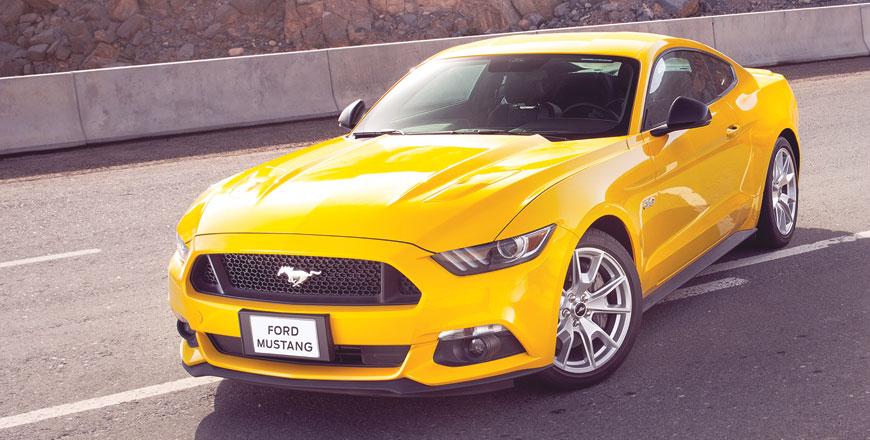You are here
Re-imagined automotive Americana
By Ghaith Madadha - Sep 07,2015 - Last updated at Sep 07,2015

Photos courtesy of Ford
 America’s most celebrated car, the Ford Mustang was first launched in 1964 and is credited with creating the affordable, accessible and visceral “Pony” and “Muscle” car segments. A second time trendsetter with its heavily retro-inspired 2005 fifth generation, the 2015 sixth generation Mustang again leads the pack with a more mature, sophisticated and refined effort that loses none of its predecessors’ evocative charisma.
America’s most celebrated car, the Ford Mustang was first launched in 1964 and is credited with creating the affordable, accessible and visceral “Pony” and “Muscle” car segments. A second time trendsetter with its heavily retro-inspired 2005 fifth generation, the 2015 sixth generation Mustang again leads the pack with a more mature, sophisticated and refined effort that loses none of its predecessors’ evocative charisma.
A feel-good car teeming with a sense of the dramatic, the latest Mustang wears its heritage as a convincingly authentic layer of traditional charm, but is backed up by thoroughly capable contemporary technology, refinement, handling and dynamic ability. Powered by an improved version of Ford’s 5-litre Coyote V8 engine, the new Mustang is the first with independent rear suspension, and so reaps ride and handling benefits.
An eye for the dramatic
Moody, aggressive and crucially a fun and charismatic car, the Mustang is a robust and practical daily drive coupe. An evolutionary design, the new Mustang’s muscularly long bonnet, lusty Coke-bottle hips, fastback body, short deck and slanted three-bar rear lights make it immediately identifiable as such. However, its design is a natural progression and more contemporary expression of what a Mustang should look like.
 Seamlessly harmonising classical Mustang traits with Ford’s contemporary and familial design language, the new Mustang’s face is dominated by a huge gaping and hungry trapezoidal grille and lower intake. With a jutting and shark-like demeanour and menacingly squinty, browed and slim headlights, the Mustang’s sculpted side intakes, powerful rear haunches, and twin-ridge bonnet surfacing, the Mustang oozes dynamic tension from every angle.
Seamlessly harmonising classical Mustang traits with Ford’s contemporary and familial design language, the new Mustang’s face is dominated by a huge gaping and hungry trapezoidal grille and lower intake. With a jutting and shark-like demeanour and menacingly squinty, browed and slim headlights, the Mustang’s sculpted side intakes, powerful rear haunches, and twin-ridge bonnet surfacing, the Mustang oozes dynamic tension from every angle.
With a keen eye for the dramatic, the Mustang is wide, low and seems ready to pounce even when still, but is aerodynamically designed for efficiency and stability, employing air splitters and dams, bonnet vents and rear spoiler. Using more high strength steel for improved safety, refinement and handling, the new Mustang is 28 per cent stiffer and features aluminium front wings and bonnet for improved weighting.
Eager and abundant
Seductively muscular, the Mustang GT’s 5-litre DOHC V8 “Coyote” is a muscular and punchy engine, developing 400lb/ft at 4250rpm and 435BHP by 6500rpm. Effortlessly gutsy from tick-over, abundantly versatile in mid-range and seamlessly progressive, eager and powerful to redline, the Mustang GT is brutally quick off-the-line, and with wheel-spin swiftly giving way to sure-footed traction can rocket through the 0-100km/h benchmark in 4.8 seconds and onto 250km/h.
Burbling, gurgling and warbling at idle, the Mustang GT’s bass-heavy medley of exhaust and intake acoustics hardens to bellow and relentless staccato growl as revs reach towards its rev limit. Eager and abundant, the GT’s muscular engine pulls hard in virtually any gear and speed and doesn’t require much downshifting, and is happy languidly cruising or briskly but comfortably tackling a hill climb at mid-range speed.
Driving the rear wheels through a smooth and concise shifting 6-speed automatic gearbox, the Mustang is able to hold gears without an automatic up-shift against its rev limiter at 7000rpm and without unwanted kickdowns at full load, when set to its “Sport” drive and gearbox modes. This allows more autonomy to the driver to feed in and finesse power deliver through corners without unwanted automatic overrides.
Connected, composed and confident
The first Mustang to ditch the traditional live axle and adopt independent rear suspension, the new Mustang’s integral-link set-up allows for fine-tuning for a smooth and comfortable ride, and firm body control and precision through corners. Well-balanced with 54 per cent front bias and with road hugging footprint and sticky 255/40R19 tyres, the Mustang GT is confident, agile, reassuring and is connected, communicative and flattering to drive.
Quick and best in its meatier “Sport” mode, its steering offers good feel and precision, and is tidy, sharp and grippy on turn-in with very little evidence of understeer over various test drive conditions, including greasily damp switchbacks. Charismatic, reassuring and predictable, the Mustang soon becomes second nature to drive, and is well adept to repetitive direction changes and regains lateral and vertical composure well from mid-corner bumps.
With slight weight shift on sudden direction change the Mustang settles into a corner with superb composure, taut body and grippy lateral control. Committed to cornering lines, it is progressive, balanced and intuitively predictable once pushed beyond its rear grip limit, with easily finessed on-throttle handling and cornering line. Meanwhile, big 352mm front and 330mm rear ventilated disc brakes tirelessly and effectively rein in its 1691kg mass.
Ergonomic and evocative
With noticeably planted stability, the Mustang is reassuring, refined and smooth at speed, settled and taut on rebound and forgiving with a faint bounce over lumps, bumps and imperfections. Meanwhile, available safety equipment is extensive and includes eight airbags, adaptive cruise control, blind spot information, cross-traffic alert and Ford Mykey, which allows owners to limit top speed sound system volume prevent second drivers from disabling driver-assist features.
Accessible, spacious and well equipped, the Mustang’s cabin features a hunkered down but well-adjustable seating position, while its’ long double ridged bonnet provides quite the evocative front view. More ergonomic than its primary rivals, the Mustang offers good visibility and spaciously accommodates large front passengers. Rear seats are useable, if not especially generous, while rear boot space is well accessible, uniformly shaped and generous at 383 litres.
Ergonomically well-laid out, the Mustang’s cabin has a retro muscle car ambiance with clear dials, gated toggle switches and thick steering wheel. Material and fit are good and include plenty of soft textures. Seats are comfortable, but stiffer side bolsters would better suit its’ high dynamic ability. Generously equipped, features include advanced Sync infotainment system with smartphone compatibility and track gauges —including a g-force gauge.
TECHNICAL SPECIFICATIONS
Engine: 5-litre, all-aluminium, in-line V8 cylinders
Bore x stroke: 92.2 x 92.7mm
Compression ratio: 11:1
Valve-train: 32-valve, DOHC, variable valve timing
Gearbox: 6-speed automatic, rear-wheel drive, limited-slip differential
Gear ratios: 1st 4.17:1; 2nd 2.34:1; 3rd 1.52:1; 4th 1.14:1; 5th 0.87:1; 6th 0.69:1
Final drive ratio: 3.15:1
Power, BHP (PS) [kW]: 435 (441) [324] @6500rpm
Specific power: 87.8BHP/litre
Power-to-weight: 257.2BHP/tonne
Torque, lb/ft (Nm): 400 (542) @4250rpm
Specific torque: 109.4Nm/litre
Torque-to-weight: 320.5Nm/tonne
0-100km/h: 4.8 seconds (est.)
Top speed: 250km/h (est.)
Fuel consumption, city/highway/combined:
14.9/9.5/12.5l/100km
CO2 emissions: 281g/km (est.)
Length: 4782mm
Width: 1915mm
Height: 1381mm
Wheelbase: 2720mm
Track, F/R: 1582/1648mm
Headroom, F/R: 955/883mm
Legroom, F/R: 1130/777mm
Shoulder room, F/R: 1430/1325mm
Luggage volume: 383 litres
Fuel capacity: 60 litres
Kerb weight: 1691kg
Weight distribution, F/R: 53 per cent/47 per cent
Steering: Electric-assisted rack & pinion
Turning circle: 11.5 metres
Suspension, F/R: MacPherson Struts/integral link, anti-roll bars
Brakes, F/R: Ventilated discs, 352mm/330mm
Brake callipers, F/R: 4/1
Tyres: 255/40R19
Related Articles
The original muscle when appearing in 1964 and first to resurrect such cars in 2005, the iconic trend-setting Ford Mustang made stylish two-
Winner of the 2015 Middle East Car of the Year Award, the latest generation of Ford’s attainable icon, the new Mustang is the most advanced,
The second ever car fully developed by Mercedes-Benz’s in-house high performance AMG tuning wing, the AMG GT is an altogether tighter, taute

Opinion
Apr 09, 2025
Apr 08, 2025
- Popular
- Rated
- Commented
Apr 08, 2025
Apr 09, 2025
Newsletter
Get top stories and blog posts emailed to you each day.

















